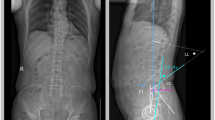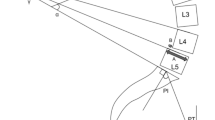Abstract
Chronic lower back pain is a potentially incapacitating condition associated with disc degeneration. Although therapy is primarily pharmaceutical, surgery comprising arthrodesis constitutes an alternative. Anterior intersomatic lumbar arthrodesis (ALIF, anterior interbody lumbar fusion) is the reference approach, although total disc arthroplasty may also be undertaken. Analysis of pelvic and spinal parameters provides the best indication of sagittal balance.
Materials and methods
This was a prospective study in a continuous series of 99 patients presenting chronic lower back pain due to disc disease. Pelvic incidence, sacral slope, pelvic tilt, spino-sacral angle (SSA) and the four back types in the Roussouly classification were studied in radiographs of the whole spine under load using an EOS imaging system.
Results
The pre-operative SSA value for the study population was 126.09° ± 8.45° and the mean spine tilt angle was 90° compared with 95° in healthy subjects. Following surgery, the SSA was considerably increased in the discal arthroplasty, resulting in a significantly more balanced spinal position. In the group of patients undergoing arthrodesis using the ALIF technique, no such significant improvement was found despite the use of a lordosis cage. We showed that in cases of low pelvic incidence, it was necessary to maintain a Roussouly type 1 or 2 back without increasing lordosis. The results demonstrated the value of L4–L5 disc prostheses in these subjects. L5–S1 arthrodesis seemed a more suitable approach for treating patients with elevated sacral slope (back type 3 or 4). This new type of analysis of sagittal parameters should be performed prior to all surgical procedures involving lumbar prostheses.




Similar content being viewed by others
References
Barrey C, Jund J, Noseda O, Roussouly P (2007) Sagittal balance of the pelvis-spine complex and lumbar degenerative diseases: a comparative study about 85 cases. Eur Spine J 16:1459–1467
Berthonnaud E, Labelle H, Roussouly P, Grimard G, Vaz G, Dimnet J (2005) A variability study of sagittal spino-pelvic radiological measurements of trunk balance with the Sagittal OptiSoft® software. J Spinal Disord Tech 18:1
Legaye J, Hecquet J, Marty C et al (1993) Equilibre sagittal du rachis, relation entre bassin et courbures sagittales en position debout (in French). Rachis 5:215–226
Duval-Beaupere G, Schmidt C, Cosson P (1992) A Barycentremetric study of the sagittal shape of spine and pelvis: the conditions required for an economic standing position. Ann Biomed Eng 20:451–462
Jackson RP, Kanemura T, Kawakami N et al (2000) Lumbopelvic lordosis and pelvic balance on repeated standing lateral radiographs of adult volunteers and untreated patients with constant low back pain. Spine 25:575–586
Roussouly P, Gollogly S, Berthonnaud E et al (2005) Classification of the normal variation in the sagittal alignment of the human lumbar spine and pelvis in the standing position. Spine 30:346–353
Roussouly P, Gollogly S, Noseda O, Berthonnaud E, Dimnet J (2006) The vertical projection of the sum of the ground reactive forces of a standing patient is not the same as the C7 plumbline: a radiographic study of the sagittal alignment of 153 asymptomatic volunteers. Spine 31:E320–E325
Rajnics P, Pomero V, Templier A et al (2001) Computer-assisted assessment of spinal sagittal plane radiographs. J Spinal Disord 14:135–142
Tournier C, Aunoble S, Le Huec JC, Lemaire JP, Tropiano P, Lafage V, Skalli W (2007) Total disc arthroplasty: consequences for sagittal balance and lumbar spine movement. Eur Spine J 16:411–421
Le Huec JC, Basso Y, Mathews H, Mehbod A, Aunoble S, Friesem T, Zdeblick T (2005) The effect of single-level, total disc arthroplasty on sagittal balance parameters: a prospective study. Eur Spine J 14:480–486
Aunoble S, Meyrat R, Al Sawad Y, Tournier C, Leijssen P, Le Huec JC (2010) Hybrid construct for two levels disc disease in Lumbar Spine: a valid alternative to two levels disc arthroplasty. Eur Spine J 19:290–296
Acknowledgments
We would like to thank Prof. Chêne Geneviève, Dept. of Public Health (ISPED) of the Faculty of Medicine of Bordeaux 2, 146 rue Leo Saignat, 33076, Bordeaux, France.
Conflict of interest
None.
Author information
Authors and Affiliations
Corresponding author
Rights and permissions
About this article
Cite this article
Pellet, N., Aunoble, S., Meyrat, R. et al. Sagittal balance parameters influence indications for lumbar disc arthroplasty or ALIF. Eur Spine J 20 (Suppl 5), 647 (2011). https://doi.org/10.1007/s00586-011-1933-0
Received:
Accepted:
Published:
DOI: https://doi.org/10.1007/s00586-011-1933-0




